Max von Widnmann
Max von Widnmann (ennobled as Maximilian Ritter von Widnmann; 16 October 1812 – 3 March 1895)[1] was a German sculptor and professor at the Academy of Fine Arts in Munich. Many of his works were commissioned by King Ludwig I of Bavaria.
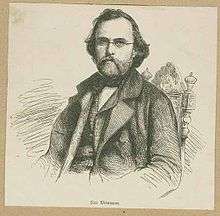
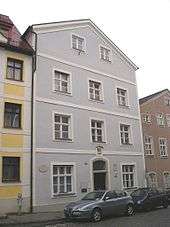
Life and career
Max von Widnmann was born in Eichstätt, the youngest of three sons of Franz Amand Widnmann, who held the positions of court, town and regional physician, and his wife Maximiliana née Pöckhel, who was the widow of Franz Seraph Ulrich, who had also held appointments as town and local physician. After attending the gymnasium in Eichstätt, where he already showed aptitude for drawing and painting, he entered the Academy of Fine Arts in Munich in 1825. There he studied with Ludwig Michael Schwanthaler among others. His teachers made it possible for him to go to Rome from 1836 to 1839, and there he studied with and became a friend of Bertel Thorvaldsen, who was already a well-known sculptor.[1][2] He was also a friend of the Cologne architect Sulpiz Boisserée, whose art collection was acquired by Ludwig I for the Alte Pinakothek in 1827.
After returning from Rome, Widnmann became an independent artist in Munich, where Ludwig I soon began to commission works from him, including portrait busts for the Walhalla memorial near Regensburg. Ferdinand von Miller cast many of his sculptures in bronze.[3]
In 1849, Widnmann became a professor at the Academy of Fine Arts,[2][4] succeeding Schwanthaler. His increasing recognition brought him many commissions from outside Bavaria. In 1849 he was made a member of the Order of St. Michael.[2] In 1887, the Prince Regent, Luitpold of Bavaria, personally ennobled him as a Knight of the Bavarian Crown.
He retired in 1887[1] and died in Munich at 82.
Widnmann's statues projected an air of dignity that appealed to his contemporaries and brought him many commissions; however, his smaller works, such as the busts, have been regarded as more artistically successful.[4][5] Some of his work was destroyed in the bombing of Munich during World War II.
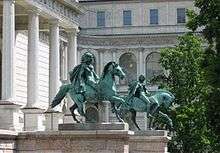
Selected works
- Busts of Christian Amberger, Hans Holbein, Georg von Freundsberg, Mandl, Rottmann
- Leo von Klenze monument[1]
- Friedrich von Gärtner monument
- Schiller[1][2] and Goethe[1] monuments in Munich
- Marble statue of Friedrich List (1847)[2]
- Marble bust of General Carl Wilhelm von Heideck in Ingolstadt[2]
- Monuments to bishops in Würzburg (bronze statue of Prince Bishop Julius Echter von Mespelbrunn, 1845),[1][2][6] Bamberg (statue of Prince Bishop Franz Ludwig von Erthal,[1] cast in bronze by Ferdinand von Miller, 1865) and Regensburg (statue of Bishop Johann Michael Sailer)[1]
- Monuments to August Wilhelm Iffland and Wolfgang Heribert von Dalberg in Mannheim (1864/66, both cast by Miller)
- Memorial to Mathilde of Hesse in St. Ludwig's Church, Darmstadt
- Statues of Orlando di Lasso[7] and Lorenz von Westenrieder on the Promenadeplatz in Munich (1848, 1854)[2]
- Statue of Christian Daniel Rauch in the Glyptothek (1856)[2]
- Monument to Christoph von Schmid in Dinkelsbühl (1859, cast by Miller)
- Bust of Jakob Bauer in the Isar meadows (Flaucher) (1861)
- Equestrian statue of Ludwig I in the Odeonsplatz (1862, designed by Schwanthaler)[1][2][7][8]
- Equestrian statues of Castor and Pollux in front of the Academy of Fine Arts, Munich (1877)[4][5]
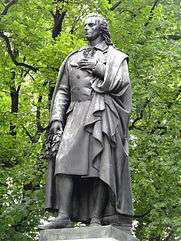
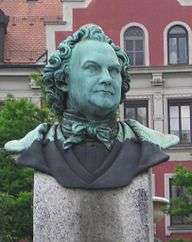
References
- Th-B, "Widnmann, Max von, sculptor", Dictionary of German Biography, ed. Walther Killy and Rudolf Vierhaus, with Dietrich von Engelhardt et al., Volume 10 Thibaut – Zycha, Munich: Saur, 2006, ISBN 9783598233005, p. 498.
- "Widnmann, Max", Friedrich Mueller, Die Künstler aller Zeiten und Völker oder, Leben und Werke der berühmtesten Baumeister, Bildhauer, Maler, Kupferstecher, etc., Volume 3, Stuttgart: Ebner & Seubert, 1864, OCLC 680290293, p. 865 (in German)
- See Angelika Mundorff and Eva von Seckendorff, eds., Die Millers: Aufbruch einer Familie, Munich: Allitera, 2006, ISBN 9783865201874 (in German), including list of works.
- "Widnmann, Max, Bildhauer", Meyers Konversations-Lexikon, 1897 ed., Volume 17, p. 720 (in German)
- "Widnmann, Max", Encyclopedia Americana, 1920 ed., Volume 29, p. 296.
- "Giesskunst", J.A. Romberg and Friedrich Faber, Conversations-Lexicon für bildende Kunst, volume 3, Leipzig: Romberg, 1850, OCLC 1443119, p. 74 (in German)
- Wilhelm Lübke, tr. F.E. Bunnett, History of Sculpture: From the Earliest Ages to the Present Time, London: Smith, Elder, 1872, OCLC 2274613, Volume 2, p. 465.
- "Ludwig 1. und sein Isar-Athen" Archived 2016-03-04 at the Wayback Machine, Alchemia Spectrum 2, January 2000, pp. 5–9, p. 7 (pdf) (in German)
Further reading
- Siegmund Freiherr von Pölnitz. "Max von Widnmann. Das Leben eines Künstlers unter König Ludwig I". Sammelblatt des Historischen Vereins Eichstätt 55 (1940) 3–19, 56/57 (1941/42) (in German)
- Edwart Mager. "Max von Widnmann. Ein vergessener Eichstätter Künstler". Historische Blätter für Stadt und Landkreis Eichstätt 27.2 (1978) (in German)
External links
